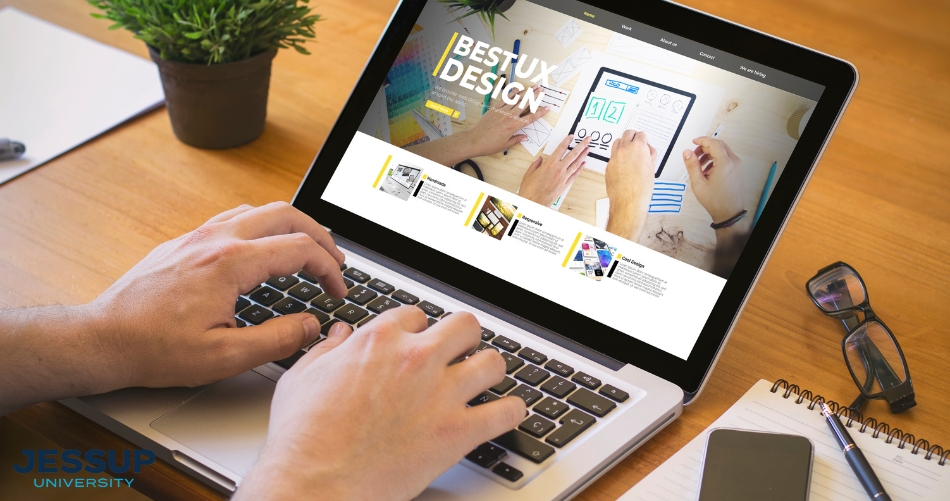Web Design London Ontario Solutions Designed to Your Company
Web Design London Ontario Solutions Designed to Your Company
Blog Article
Exactly How to Effectively Integrate Visual Appeals and Capability in Website Design
When creating an internet site, you need to strike a balance between appearances and capability. It's not almost looking great; your layout needs to additionally offer a purpose and guide individuals successfully. By concentrating on simpleness and instinctive navigation, you can create an appealing experience. What aspects truly enhance functionality while preserving aesthetic appeal? Allow's discover the crucial concepts that can cause an unified mix of elegance and feature.
Recognizing the Value of Visual Appeals and Functionality
When you create an internet site, recognizing the equilibrium between aesthetic appeals and performance is necessary for developing an efficient individual experience. A visually appealing website grabs attention, however it's the functionality that keeps individuals engaged. Visitors will quickly shed interest and leave.Consider your target audience and what attracts them in if your site looks terrific but is hard to navigate. You wish to produce a design that shows your brand name while making certain ease of use. Streamlined formats, user-friendly navigating, and clear contact us to activity can enhance both aesthetic appeals and functionality.

Concepts of Efficient Web Style
To create a reliable website design, you require to comply with numerous essential concepts that enhance both customer experience and visual allure. Focus on simpleness; a clean design helps individuals browse easily. Use a constant color design and typography to keep coherence throughout your site. This cultivates familiarity and trust.Next, assure your design is responsive. Customers access websites on different tools, so your design ought to adjust flawlessly. Take note of aesthetic hierarchy; emphasize vital aspects with dimension, color, or placement to lead customers' focus.Finally, incorporate adequate white room. It prevents clutter and makes material extra absorbable. Remember, efficient website design balances aesthetic appeals and functionality, so every style selection need to offer an objective. By following these principles, you'll create a site that's not only aesthetically appealing however likewise easy to use, eventually maintaining site visitors involved and encouraging them to return.
Prioritizing Individual Experience
When prioritizing user experience, you'll wish to begin by recognizing what your customers truly require. Streamlining navigating style can make a huge distinction in just how quickly they discover what they're seeking. Additionally, boosting aesthetic pecking order assists lead their interest to one of the most important components on your website.
Comprehending User Demands
Recognizing customer demands is necessary for developing an interesting web experience that maintains site visitors coming back. To accomplish this, you must recognize the goals and choices of your target audience. Start by performing individual study, like surveys or meetings, to collect insights on what customers value most. Take notice of their discomfort points and difficulties when engaging with similar web sites. This details allows you to tailor your layout, making certain performance straightens with user assumptions. In addition, think about developing user identities that stand for different sections of your target market, assisting you visualize their requirements throughout the style procedure. When you focus on understanding individual demands, you create a site that not just looks wonderful but additionally delivers a seamless, satisfying experience that cultivates commitment.
Streamlining Navigation Style

Enhancing Aesthetic Power Structure
A solid visual power structure is crucial in leading individuals with your site and ensuring they involve with crucial material. To accomplish this, use spacing, shade, and size strategically. Make essential elements like headings bigger and bolder than body text, attracting interest promptly. Make use of contrasting shades to highlight phone calls to action, urging clicks. Furthermore, employ adequate white room to different areas, making content absorbable and inviting.Consider the circulation of information; organize elements practically, leading individuals' eyes from one point to the following. Use aesthetic cues, like lines or arrows, to route interest. By focusing on visual hierarchy, you improve customer experience and boost the possibility of conversions, guaranteeing your site is both cosmetically pleasing and functionally efficient.
Shade Theory and Its Influence On Usability
While picking the best shades for your website might appear like a small information, it greatly influences use and customer experience. Color influences how individuals regard information and can boost or hinder navigating. For example, contrasting shades can aid crucial components stand apart, making it easier for visitors to discover what they need.Additionally, take into consideration the psychology of shades: blue typically motivates trust, while red creates seriousness. Understanding your target audience can assist your shade selections, assuring they resonate well.Moreover, constant shade plans aid construct brand name identity, making your site extra memorable. Be cautious-- too many colors can bewilder customers. Stay with a minimal combination that matches your content and maintains clarity.Incorporating ease of access is also vital; confirm your color combinations get along for those with aesthetic disabilities. By thoughtfully using shade theory, you'll enhance usability and develop a much more appealing user experience.
Typography: Balancing Style and Readability
Color selections established the stage for your website, yet typography plays a similarly essential role in boosting individual experience. You want your message to interact clearly while also mirroring your brand name's personality. Beginning by selecting fonts that are not just appealing however also understandable. Sans-serif font styles frequently function well for digital screens, as they're much easier to read at numerous sizes.Maintain a hierarchy by using various typeface sizes and weights; this guides customers through your content easily. Think about line spacing and letter spacing; as well limited can irritate readers, while also loosened can interrupt the circulation. Limitation your typeface options to 2 or three to maintain the design cohesive.Finally, always examine your typography across various devices and internet browsers. What looks good on one display might not on an additional. Balancing style with readability warranties that your message reverberates, keeping your target market engaged and notified.
Responsive Style: Making Appearances Deal With All Tools
To assure your site looks great on any type of tool, you'll need to accept receptive layout concepts. This method assurances your website adapts to different display sizes, providing an optimal customer experience. Start by utilizing fluid grids and versatile photos that scale flawlessly. Instead of repaired measurements, choose percentages and family member systems, enabling your format to readjust dynamically.Next, implement media questions in your CSS. These let you apply different styles based on gadget features, like display size. This way, you can preserve visual charm while assuring functionality.Don' t neglect about touch targets; make certain buttons and web links are easy to touch on smaller screens. Prioritize crucial web content, so customers can conveniently browse your site no matter of their tool. By concentrating on these components, you'll produce an interesting, aesthetically appealing experience that satisfies the demands of all individuals, whether they get on a desktop computer, tablet computer, or smartphone.
Conducting Use Screening for Constant Improvement
To enhance your website design, you need to set clear use goals that align with customer requirements. By conducting customer examinations, you can gather useful comments on how actual people interact with your website. Examining these results will certainly assist you make informed renovations and produce a more efficient user experience.
Specifying Usability Goals
While looks can draw users in, specifying usability objectives is necessary for ensuring their experience stays seamless and enjoyable. Start by recognizing what you want individuals to achieve on your site (website design london Ontario). Consider their needs, habits, and jobs. Are they looking for info, making an acquisition, or registering for an e-newsletter? Establish clear criteria to gauge success, like task conclusion prices or time on task. Focus on intuitive navigating, obtainable web content, and receptive layout to boost functionality. On a regular basis revisit these objectives as customer assumptions evolve. By defining functionality goals, you produce a structure for reviewing and improving your site's efficiency. This emphasis on use not just boosts user contentment yet also strengthens the general efficiency of your layout
Performing Customer Examinations
Performing user tests is vital for fine-tuning your web site and ensuring it satisfies your target market's requirements. Beginning by identifying your target users and creating an examination strategy that details your purposes. Make use of a mix of qualitative and quantitative methods, such as surveys, meetings, and task-based observations, to collect comprehensive feedback. Welcome participants to navigate your site while you observe their interactions and note any difficulties they experience. Motivate open discussion to catch their ideas and feelings about the design and functionality. Keep sessions short and concentrated, guaranteeing you cover essential areas without overwhelming individuals. Make sure to record all findings, as this details will certainly be vital for making informed layout choices that enhance both appearances and functionality.
Analyzing Test Outcomes
How can you efficiently analyze the outcomes of your usability tests to drive constant improvement? Begin by classifying feedback into usual styles. Seek patterns in individual behavior that highlight discomfort points or areas for enhancement. Usage quantitative information, like task conclusion rates and time on task, to gauge usability fairly. Don't neglect to take into consideration qualitative understandings from user comments; they typically disclose underlying issues that numbers can't show. Prioritize one of the most impactful findings and produce workable items for your design group. Remember, it's concerning repeating-- execute modifications, after that test once more. This cycle of testing, analyzing, and refining helps you equilibrium aesthetic appeals and functionality, ensuring your site fulfills customer demands properly while preserving aesthetic appeal.
Frequently Asked Concerns
Just how Do I Choose the Right Color Combination for My Web site?
To pick the appropriate shade palette for your website, consider your brand's personality, target audience, and psychological influence (website design london Ontario). Usage shade psychology, produce consistency, and warranty readability. Examination mixes to see what reverberates website ideal with site visitors
What Devices Can Assist With Website Design Visual Appeals and Performance?
You can utilize tools like Adobe XD, Figma, and Map out to improve your website design's visual appeals and functionality. These platforms offer intuitive user interfaces, cooperation attributes, and pre-made themes to simplify your imaginative procedure and enhance your styles.
Exactly How Can I Integrate Animations Without Compromising Capability?
To include computer animations without endangering performance, prioritize refined results that boost individual experience. Use CSS animations for smoother communications, warranty fast load times, and examination on numerous tools to maintain performance while adding visual charm.
What Prevail Blunders to Avoid in Web Layout Visual Appeals?
When designing, stay clear of messy layouts, inadequate color choices, and inconsistent typefaces. Don't forget mobile responsiveness, as it can push away users. Verify your design straightens with your brand name, creating a smooth experience that engages site visitors successfully.
How Usually Should I Update My Website's Layout for Optimal Aesthetics?
You must update your web site's design every 1-2 years to stay on top of patterns and maintain suitable aesthetic appeals. Routinely restoring visuals helps engage guarantees and site visitors your site stays enticing and user-friendly. When you create a website, recognizing the equilibrium between looks and functionality is necessary for developing an effective customer experience. To produce an efficient internet layout, you need to adhere to a number of crucial principles that improve both individual experience and aesthetic allure. Users access web sites on different tools, so your layout should adapt flawlessly. When prioritizing user experience, you'll want to begin by recognizing what your users really require. Begin by performing customer study, like meetings or studies, to collect understandings on what customers value most.
Report this page